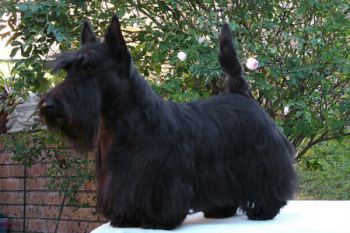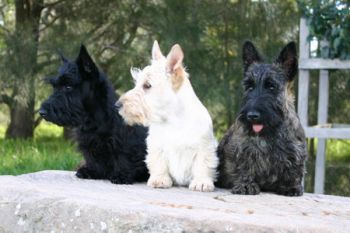The Scottish Terrier
| Size | |
| Exercise Requirements | |
| Grooming Requirements | |
| Weight | 9 - 11 Kg (approx) |
| Life Span | 10-15 Years (approx) |

The following breed information has been kindly provided by
The Scottish Terrier Club Inc NSW - Australia
Secretary Contact : Leanne Rose.
The Scottish Terrier Club Inc. NSW - Australia
Our Club was formed in 1937 to promote the breeding and showing of Scottish Terriers. The club aims to help both show and pet owners with our knowledge of the breed. Whilst based in New South Wales, we have members across Australia and the world. The club conducts a number of specialty shows as well as attends selected shows in mass to promote the Scottish Terrier in the Community. Like all dog breeds, we are highly competitive in the ring, but when the judging is finished we all join together to make the day a social occasion.
Leanne Rose (Secretary)
The Scottish Terrier is a unique breed, but owners say once you been owned by a Scottie, it’s hard to have another breed.
HISTORY
When you think of Scotland, you immediately think of tartan and the Scottish Terrier. The exact origin of the Scottish Terrier is unknown. All that is known is that a terrier on short legs with a rough coat existed in the Western Highlands of Scotland and the Islands of the Hebrides. This terrier evolved into the Scottish Terrier, the Skye Terrier, the Dandie Dinmont, the Cairn Terrier and the West Highland White. It was not until 1879 that the breed was officially recognised as the Scottish Terrier. The first Scottish Terriers were imported into Australia in 1889.
Scotties became very popular during the 1920’s. Many people in the public eye have had Scotties. In show business, they include Lionel Barrymore, Humphrey Bogart, Bette Davis, Zsa Zsa Gabor, Dorothy Lamour, Walter Pidgeon, Basil Rathbone, Julie Andrews, Ali McGraw and Liza Minnelli. In the political arena Queen Victoria, Eva Braun (Hitler's mistress), President Eisenhower, Jackie Kennedy, Franklin D. Roosevelt with his Scottie "Fala", Ronald Reagan and President George W. Bush who has a black Scottie, Barney, and a brindle bitch, Miss Beasley.
Scotties were used extensively to decorate Biscuit Tins, Cigarette Cards, statues and Art Nouveau jewellery. These items are very collectable. They were featured widely in advertising including the famous Black and White Whiskey featuring a Scottie and a Westie. More recently a Scottie featured as the Chum dog advertising canned dog food.
With "designer dogs" and "wash and wear" dogs, the work required breed and then to present a well groomed Scottie in full coat has resulted in their decline, however recently there has been resurgence in interest in the Scottie with far more enquiries than available pups. The future is looking brighter. Today the Scottie can be maintained easily in clipped trim for non show Scotties.
PURPOSE
Scottish Terriers were used to control farm and estate vermin such as badgers and foxes. Dogs were selected for their gameness and hunting ability. They had to be fearless enough to attack any prey, small enough to go down burrows , strong enough to fight their way back out and hardy enough to withstand a rough life and rigorous climate of Scotland. Scotties are often referred to as "Diehard".
CHARACTERISTICS
The Scottie was bred for independent hunting. When the Scottie went down the burrow facing a badger, there were no humans to give directions so the Scottie had to be intelligent. This independence can be mistaken for being reserved and stubborn. Scotties are extremely loyal, faithful, courageous and highly intelligent. Their physical characteristic reflects their heritage.
Scotties are thick set with short legs. They are very agile and active. A big dog in a compact body.
The Scotties head is his trademark. The head is distinctive and gives the impression of being long for the size of dog. The long eyebrows and beard protect them underground. The beard is to protect the Scottie during attack. Often when vermin attack they got a mouthful of hair instead of inflicting a wound on the Scottie. They have a strong muscular jaws and neck capable of dispatching prey with a single shake.
The Scottie has a deep chest which he rests on when digging underground with his large front paws. The rear of the dog is muscular to be able to drive hard against a foe in the burrows and field. Their stout tail was used to pull the Scottie out of the burrow. The Scottie’s short legs are not conducive to great speed, but for rough country and over rocky cairns he has hardly an equal.
Like many Terriers that go to ground, the Scottie has a strong bark. When he meets a badger underground, he would start to bark allowing the humans above to locate the badger (and Scottie) before digging the badger out and relocating him off the farm. An early form of conservation!


TEMPERAMENT
Scotties are alert and active. They are terriers and will pounce on anything which makes a sudden movement whether it is a mouse or a ball. In past times, they have been described as the Dour Scot. Careful breeding has developed the Scottie into a fun loving, friendly, loyal and loving companion.
COAT
The coat is a double one; outer is harsh, dense and wiry; undercoat short, soft. The coat gives all-weather insulation and protection during their original work. A mouth full of hair was often the only protection provided for the skin when attacked.
The coat can be black, wheaten (the colour of wheat) or brindle of any shade (a mixture of Black, Brown and Wheaten hair). The early Scotties were mainly shades of brindle, similar to that of the Cairn Terrier. The Scotties became popular in the 1920. At that time, breeders focussed on producing the all black Scottie with the underskirt we see today. Wheatens have always existed as a recessive gene and account for about 4% of the population. The average coat grows thick and profusely and requires regular care.
HEALTH
Scotties are fortunate to have few serious genetic problems compared to other pure bred dogs. Some genetic problems seen occasionally are
Von Willebrand’s Disease. A bleeding disorder. In fact, it is the most common bleeding disorder, and has been detected in over 54 dog breeds. Genetic testing and selective breeding has reduced the incidence of vWD and its consequences.
Scottie Cramp. Rarely seen today. Affected dogs are perfectly normal until the animal’s level of excitement or stress increases. This results in short term loss of muscle control and coordination. When the Scottie rests, he quickly recovers as if nothing had occurred.
Cushing’s Disease. The main cause is a tumour on the pituitary or adrenal gland Symptoms include drinking large amounts of water and urinating frequently, losing coat, loss of muscle tone and developing a pot belly. Sometimes hard to diagnose as the symptoms may be caused by other things.
The most common health issue facing Scotties are the consequences of being overweight due to over eating and too little exercise!


SUITABILITY
Scottish Terriers are hardy, adaptable small dogs and suitable for any size of house or apartment. Scotties are not over active dogs and require minimal exercise. A half hour walks a couple of times a week is quite enough. While generally dependable with very young children, they are probably at their best with an older family. They can be very protective making them ideal companions. They are terriers and if left without stimulation will find ways of occupying their time. They are highly intelligent and need a reason to do things. If let be they will decide what they will do and when they will do it! Scotties require consistent training otherwise they will try to become the boss of the household. A growing number are successfully doing obedience and agility.
GROOMING
Grooming is best done once a week, brushing energetically with a hard bristle brush and comb thru the coat to the skin.Pets need to be trimmed using clippers and scissors about 4 times a year to keep the “Scottie” look. If left untrimmed their hair will grow and the dogs will lose their distinctive body shape.
Show dogs coats are hand stripped to maintain the harsh double coat. Stripping is usually necessary two or three times a year when the top coat has become too long. The coat is removed by hand and/or stripping knife. When the coat is ready, it is easily removed without any discomfort to the dog. Clipped areas on the Scottie are the throat and ears. The show coat can also be rolled, by removing a proportion of topcoat every 2-3 weeks for indefinite period. This method is of particular useful for exhibitors as it enables them to keep the dog in show coat all year round rather than the customary stripping two or three times a year. Most show dogs would be worked on at least once a week to keep their coats in top condition.
Find Scottish Terrier Breeders
or
View Scottish Terrier Puppies for Sale | View Scottish Terrier Older Dogs for Sale


